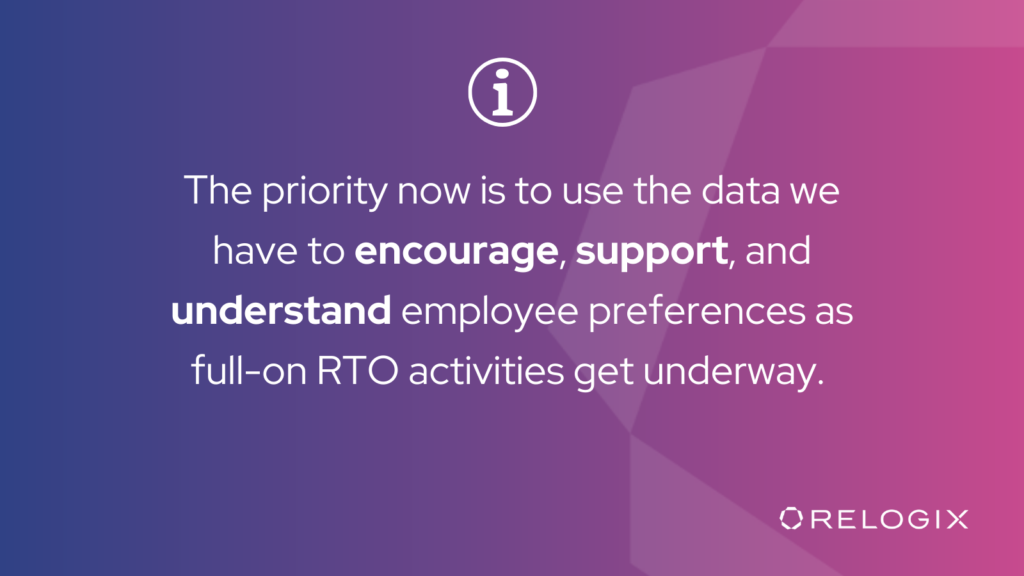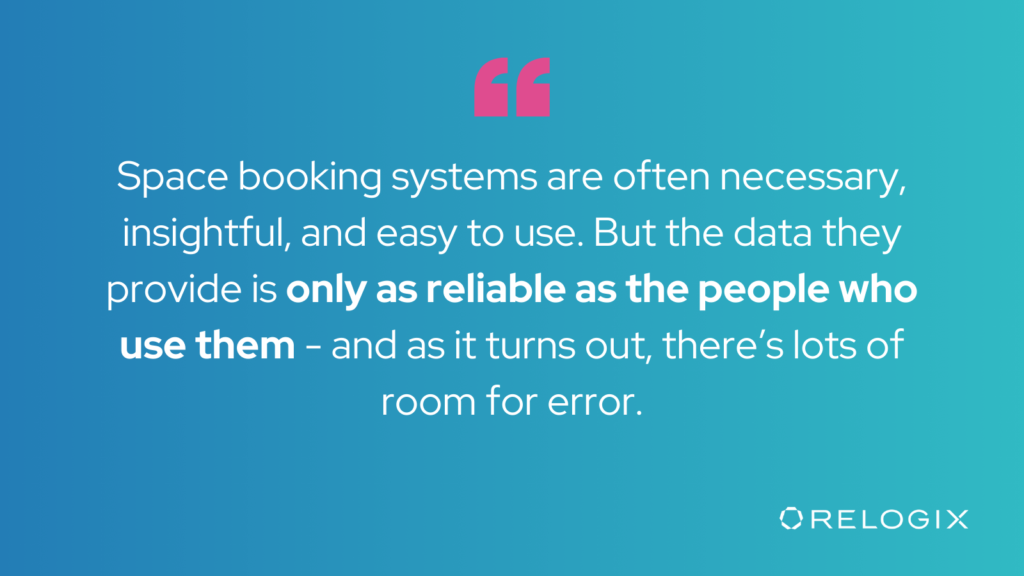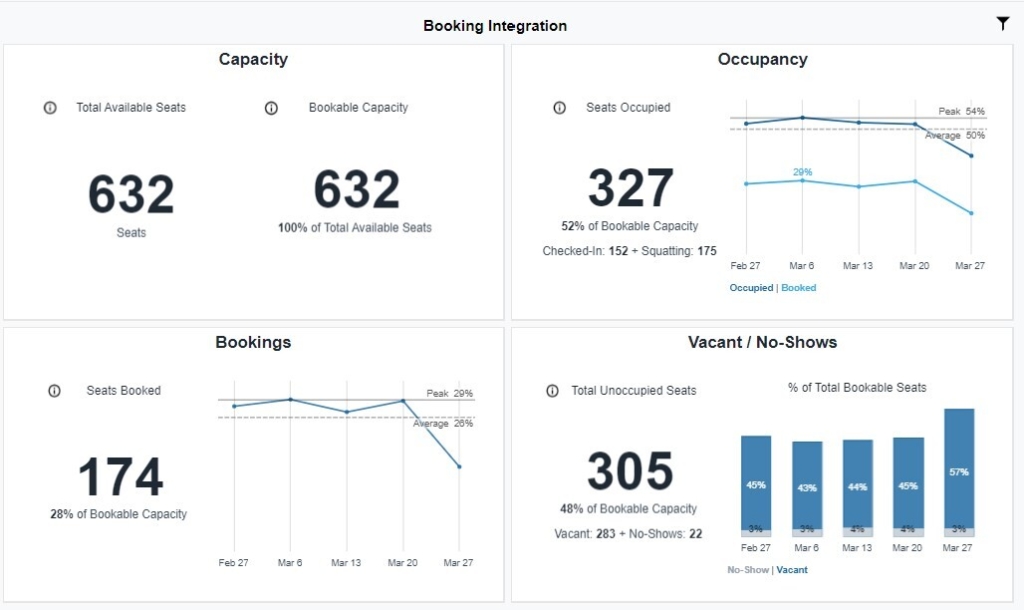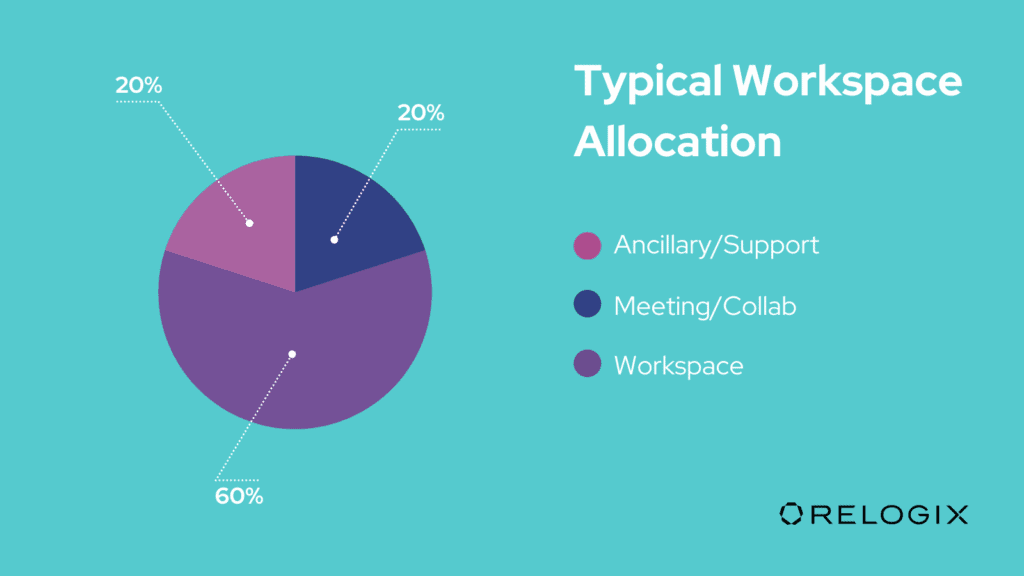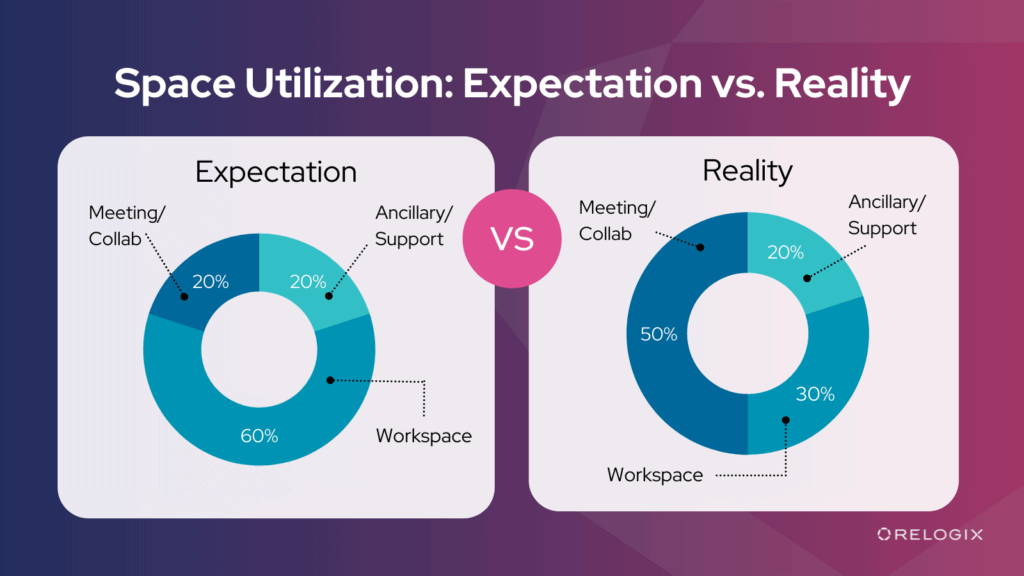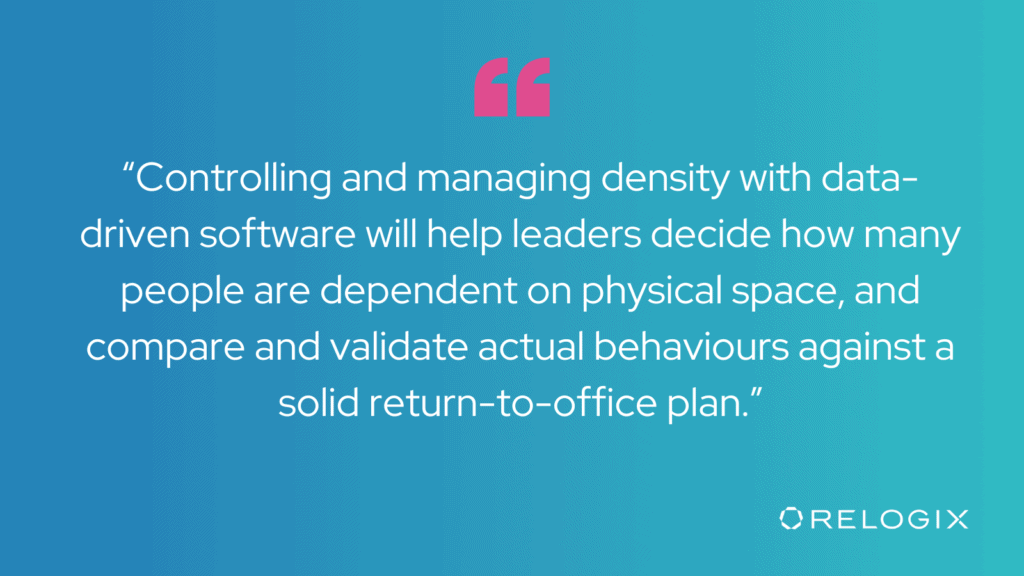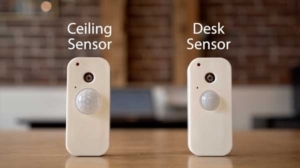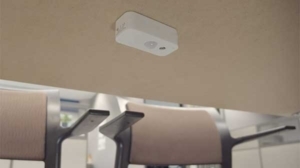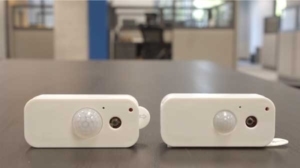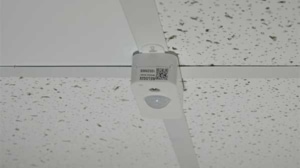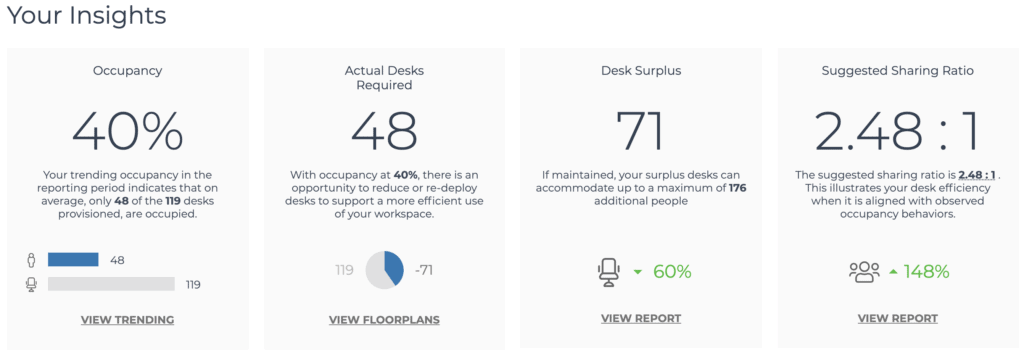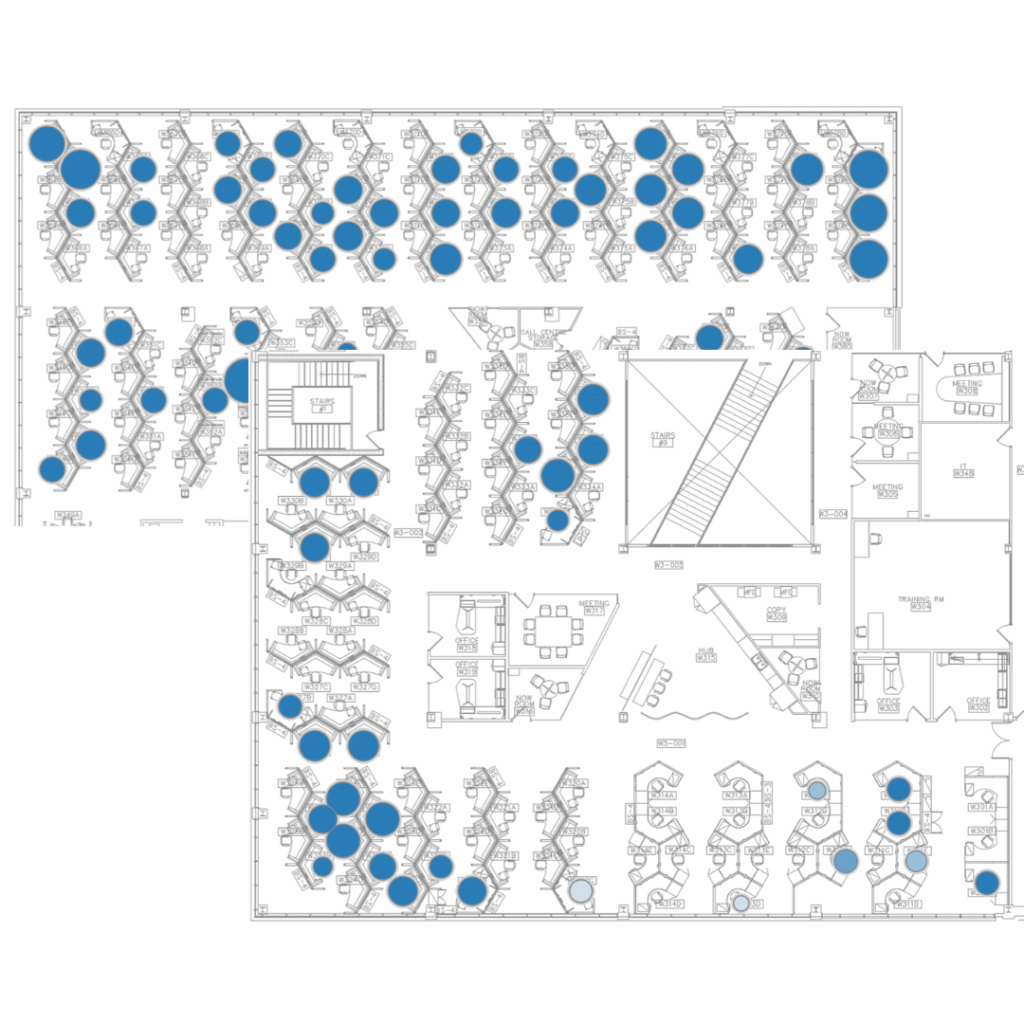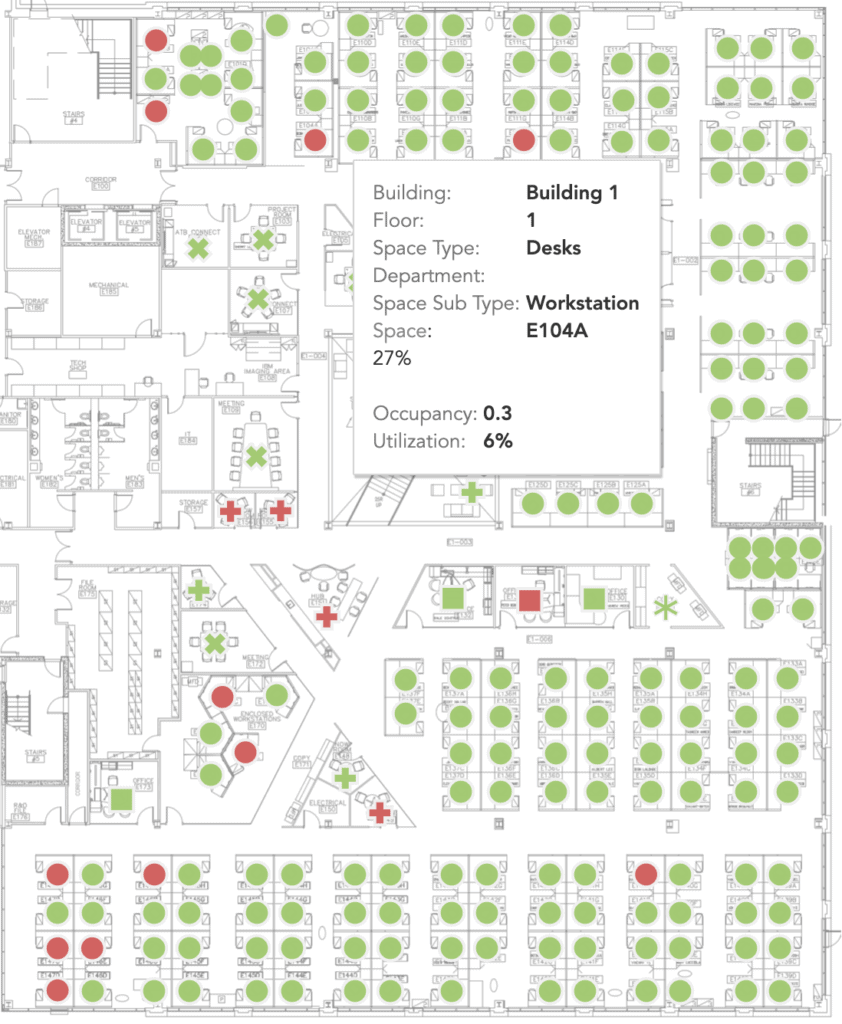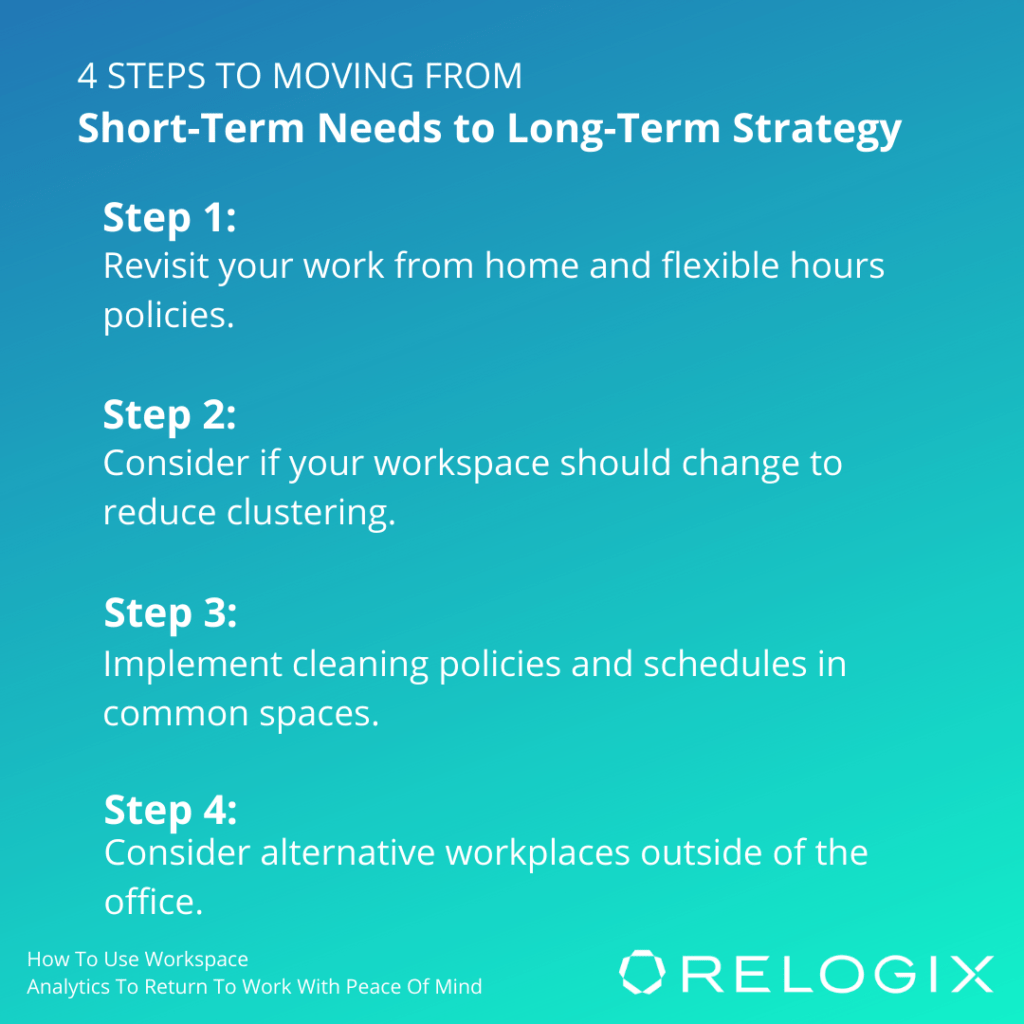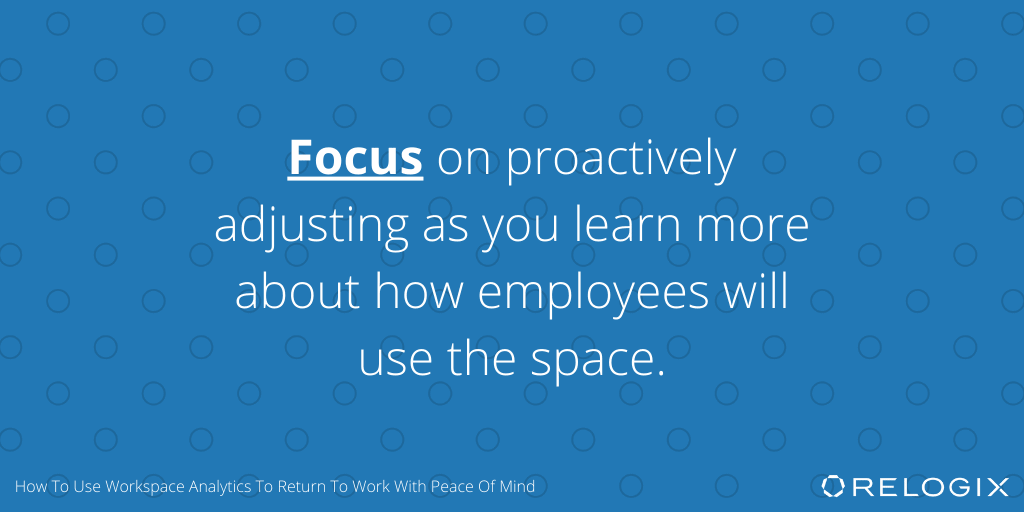Let’s Get Real Episode 33: Humanizing Workplace Data and Managing the Change to Hybrid
Discussions on the Workplace and Corporate Real Estate Podcast
Key Takeaways & Discussion Points
- How do you allocate people and spaces when occupancy and utilization patterns are continually in flux, and peoples’ patterns continue to change?
- How much did the pandemic actually change typical weekly patterns? Is there even a weekly pattern?
- What do you do when your data-driven suggestions fall flat in front of the C-suite?
- How is the role of the team manager changing, and how can we train them to evolve their role?
- How do quantitative and qualitative data work together to create an accurate story of what’s going on in your workplace?
- What considerations go into protecting privacy when it comes to gathering and using data? How do privacy requirements affect the granularity of your data?
- There aren’t necessarily correlations between being high-performing and being in the office — it’s all very individualized.
- From a change management perspective, how do you communicate effectively with employees about the shifting and evolving ways of working that will affect them?
- Are young people going to adapt better (or differently) to hybrid work due to their asynchronous, online education experience during the pandemic?
- How can companies be smarter about where they’re spending their money to build real, lasting success and employee well-being?
Links:
- Sandra Panara – Director of Workplace Insights at Relogix
- Kevin Sauer – Director of Workplace at Join Digital
If you liked today’s show, check out more episodes of the Let’s Get Real Podcast! This podcast is available on iTunes, Spotify and Google Podcasts.
Transcript:
Sandra
Hey everyone, welcome to Let’s Get Real with Sandra and Friends, a workplace consortium podcast brought to you by Relogix. I’m excited to be sharing conversational musings about current events and how we envision the ever-changing world of work. I’m Sandra Panara, Director of Workplace Insights at Relogix. With 25 years of hands-on experience, I help value engineer global workplace portfolios and employee experiences by aligning workplace analytics with corporate real estate needs.
Have any questions, comments, or suggestions for future podcasts? Please drop me a line at [email protected].
Today’s guest is Kevin Sauer, a workplace strategy and technology leader with more than 20 years of experience in building high-performing workplace strategy programs for Fortune 500 companies. Kevin is passionate about understanding the impact of emerging and innovative technologies, people strategies, and space usage on the changing nature of work.
Kevin’s expertise includes developing Amazon’s workplace intelligence program to uncover new patterns and practices and their impact on the changing workplace. He has also held Workplace Strategy roles at GE, HP, and Microsoft. Kevin’s diverse background in research design and business gives him a unique perspective and valuable insights. We’re thrilled to have Kevin on the show today to share his experiences and knowledge with our listeners.
Hey, Kevin! Very happy to have you on as a guest today. We’ve interacted in the past on many occasions. Why don’t you tell us a little bit about yourself?
Kevin
Thank you for inviting me! I’ve been in workplace strategy for 20+ years now, all with large technology companies and largely focused on global workplace and workplace experience. That’s been the area I’ve focused on, and discovery and research. As you know, things have changed dramatically in the last few years, but a lot of the things we’ve been discussing for those past 20 years are now coming to fruition. And then it’s about what happens next. How do we inform the future and how do we actually understand what we want to do next?
Sandra
Great! So, you’ve been on the inside. Even though obviously you’ve been working in workplace strategy, you’ve also been in a corporate real estate team. What are some of the challenges that you’ve faced over the last 3 years from that perspective?
Kevin
Part of the biggest challenge is trying to level set on a data-based approach. Initially the things that were gathered were badge data, utilization data, things like that. And inevitably C-suite seems to think that if you’re a high-attending company, that means people are coming in all the time. And getting that first baseline of qualifying what a high-attending company is, it means you’re getting upwards of 80, 82% of people coming in. In my case, Monday through Thursday, pre-pandemic.
But when you back away and look at it in the course of a year, there’s seasonality, there are different business cycles. So, what you find is that in reality, over the course of the year, average days in the office are really 3 to 4, not 5 days a week. There’s a very small percentage that regularly shows up 5 days a week, and when you factor in vacation and travel and all the things that happen, it makes perfect sense.
But it’s tough to elevate that to the C-suite level, so they start with the understanding that people are already to a certain degree working away from the office, and that’s continued to trend downwards over the years. That happens to be just a larger correction during the pandemic.
Sandra
That’s interesting, about being a high-attending company. Certainly, there’s been a lot of focus on occupancy, or some like to call it attendance, in the workplace. But what about when it comes to planning? You’ve got occupancy, which is just how many people are coming into the office every day versus the actual activities that are occurring in the organization. Were you leaning more towards one versus the other and how did you use the different data points?
Kevin
We really focused on the utilization side. What’s being used by how many people for how long. So, sensors are really critical in getting that fine-tuned understanding of what’s happening now, how it’s changing over time. For example, if we see meeting size, particularly in the US, getting smaller, maybe we don’t need lots of large meeting rooms, especially after the pandemic. Most people find it’s more equitable if you do those from home or elsewhere, and you all dial in and have that same kind of setting.
And when you do go to the office, you’re looking for those smaller spaces where you convene with 2 or 3 people. So we’re trying to understand how often that happens when you run out of space, and comparing that to attendance, occupancy and utilization, to triangulate when and where you need space, how often, and what degree of discomfort are you willing to accept on those peak days, particularly Tuesday through Thursday. Can you average that out so you’re not over-subscribing the space? Or under-subscribing? We’re trying to allocate people as their patterns continue to change.
Sandra
You said that people are coming in on average 2 to 3 days a week. That’s been a pattern that existed long before the pandemic. It begs the question of how much really changed during the pandemic, other than formalizing a behaviour that already existed. But when you think about the changes that are required within the office, the fluctuation that’s already happening now on a day-to-day basis because everybody’s looking at the data — how do you plan for that? How much fluctuation did you see on a day-to-day, week-to-week basis, and how do you think about planning for those fluctuations?
Kevin
I think the simple answer is it’s still in question whether fluctuation is significantly different than pre-pandemic. You could pretty much count on a weekly cycle of when people would come in. They had their typical weekly patterns. You see many more people that come in sporadically once or twice a month, so there isn’t that week-to-week consistency. So when I was tracking more recently, we were seeing 70 to 80% of the people would attend at least one day a week during the month. And when you step down to a week, you’d see that be about half.
From an experience perspective, what that means is when you come to the office, you’re not seeing the same people as you did before. You’re seeing a completely different mix and there’s no regularity or pattern to it. So that means your experience is different every day you decide to come in and that helps inform what happens and when you decide to come in next time. It’s challenging to understand what that looks like now.
The goal is to trend that over time and see whether people start to settle into more of a typical pattern, like a flat line, where you’re seeing things stabilize. It’s going to take a fair bit of time to reform new habits after we’ve all gotten comfortable in the past three years. Now we’ve got to try to think about more choice and more opportunity, and what does that look like. You pair that up with what your team is doing and what others in the office are doing.
Sandra
Yes. What about with respect to what you were saying about the fact that you’re essentially bringing new information forward to your executives? Was there an “aha!”? Were they surprised to hear people were only coming in three days a week? What was their reaction?
Kevin
I think so, but then it jumps back to, we still really need people back in the office because it’s the best place for them to be. It wasn’t backed by data and research. I mean, there have been a lot of white papers over time that talk about the amount of time you need to get together. And certainly coming out of the pandemic, it’s focused on the idea that there needs to be a purpose. I think that’s been echoed by a lot of companies that would provide a free lunch and they’d see a spike in attendance at noon hour, but that’s it. So certain amenities, and things that were kind of big-ticket items with companies pre-pandemic have gone away. It’s trying to think about it from a management perspective — what do I need to get people into the office, and how do I get them there? And then how does that become a great experience that you want to replicate?
Sandra
Yes!
Kevin
And executives struggle with that because it’s not a one-size-fits-all. It comes down to every team creating their own strategy around what works best for their team, for the product or service they’re working on. And that’s really hard to control and trust that each managing director is really going to have the company’s best interests at heart versus trying to make sure they don’t lose talent or concerns that we’re losing talent. So the default is, well, if we force a kind of standard and allow some flexibility around that, we’ll get what we want.
Sandra
It’s certainly interesting that a lot of companies are doing that, leaving it to the individual team managers to decide, within the parameters of whatever the policy is for flexible work. They’re basically trying to rally their team together. I often wonder, though, obviously if you’re directly managing a team on a day-to-day basis, then that would probably be something you’d participate in to encourage team camaraderie, whether it’s getting together or however it is that you work. But I often wonder, is that really the role that management should be playing? It almost feels like, as of late, we’ve all become autonomous beings. We know who we work with on a day-to-day basis and we make decisions ourselves with respect to what is the most productive use of our time.
And again, you have to consider the team as well. I’ve heard a lot that it’s almost like the team aspect seems to be a lot more forgiving because there’s that human element to it, versus it’s all about business. What are your thoughts in that regard?
Kevin
I agree, and that’s actually one of the areas where HR really stepped up to the plate and said, let’s not focus on individuals, because individuals change and have their own preferences and it may or may not suit the team. The focus is on thinking about how the team works, what enables them best, and the manager is in the position to determine what that really looks like. The next step is to develop some more training around how managers think about what’s really critical about their team coming together, how their work is actually spent. What portions of the day do they need to do that so they can actually think strategically about bringing people together, setting a clear agenda, who’s playing what part, how to prepare, so there’s some kind of build-up and excitement around getting together and getting some good work done. And then we’ll go back and start working on our individual pieces of the project.
Sandra
Let’s shift gears a little bit. I know from working with you in the past that there was some stuff happening about a fact-finding design, which is top of mind to a lot of organizations right now as they’re rethinking their space. How do you go about collecting the data? What are the steps you took to get at good data?
Kevin
There were a couple of different approaches. First up, just what was commonly available, which is badge data. We actually had security put up badge readers on the way out, so we could get badge in and badge out, so we could get dwell time and rule out some theories about people only coming in for free lunch or to have a meeting, then they go home. We actually found that if people made the trip into the office, they were there for the whole day, there was a fairly large curve on that.
We also saw younger employees that took the office as their social space, and would stay much longer than your average 8-, 9-hour day. Fewer people would actually show up for just a short period of time
That was the first step, getting the attendance data to figure out, of those assigned, who’s coming in, where they’re coming to? Are they coming into their assigned area or are they just coming to the closest and most convenient office building? There was a lot of shuffling around that, depending on the type of building where the team is going to be.
The next step was looking at how the space is being used when they come in. Using a mix of sensors, as well as traditional time utilization studies, walk-arounds so you know what activity is actually happening.
And then the last piece is doing a bit of surveying to actually understand what’s getting in the way of people coming into the office and about how they actually want to spend their time.
Once you blend that, there’s an opportunity to go back and have some focus groups to make sure that what we thought the data meant was actually what employees were trying to express in their surveys. It was a good way to at least start to build a story of what’s happening now, and what’s missing. I think there have been some good industry surveys that pull this apart and found that yes, there is a trend towards the most innovative companies and those people wanting to come into the office more of the time, but they’re not there today. There are still barriers, the commute, and other things are getting in the way. There’s an opportunity to start listing out things to work on and continue to measure.
Sandra
Were you looking at those data sources individually or were you integrating them together?
Kevin
It was a bit of both. The first step was to make sure the data and emotions were correct. You have to get accurate data and then you have to humanize the data. When you’re looking at badge data, did you strip out people that are on maternity leave or long-term care, or maybe just started or just finished their employment during that week, so that you’re looking at the typical employee profile? You need a clear image of what the normalized population is doing. Get that correct, go to the next bucket.
Utilization. Test, make sure you’re getting the right data, that there are no errors or gaps in what’s being assembled there, and then start putting that together. That’s really the foundational piece.
The more insightful areas are when you start rolling in some of that talent data. That’s where the People Experience team becomes really important because they can look at a lot deeper elements around DE&I. Are we addressing the needs of all the core demographic of this company? Are there things we need to separate out so it isn’t a one-size-fits-all? Can we start to think about buckets that are more manageable and focused on populations we’re getting at?
They’re also able to look at employee ZIP code analyses. There was a big shift, pre-pandemic, a lot of employees that were approximate to the campus, so they regularly attended. A lot of dispersion post-pandemic, so when you think about companies that are saying “come back”, well, we have employees that have moved far away. It’s not possible for them to come back, because they’ve gone places where they can afford a lifestyle, where housing is less expensive. Maybe it’s closer to family, and the commute is greater. Then going to work becomes a business trip, and you’re not going to take a business trip every week.
Sandra
It’s interesting, I like what you said about humanizing the data, because I think that sums it up really nicely. When you talk to people about data in general, people tend to shy away from it because it’s quantitative, not qualitative. It doesn’t really tell you much about people. But I think, as you just described, when you begin to bring in context, and you’re able to marry together different data sources to understand the attributes of the people behind the data, you learn who they are. Where they live, different things about the job they do, the teams they belong to. There are some interesting things that bubble up when you start to look at data from that point of view.
Having said that, this doesn’t replace, or it can’t be exclusive of the true qualitative data, which is understanding other things that won’t necessarily come up from looking at numbers or from a sensor or a badge swipe. And you described people moving away — you can see that in a postal code that someone lived here and now they’re 20 miles further away from the office. So the likelihood of them coming in is not that high because they’ve moved further away.
From an analytics point of view, did you do all the analytics in house with the corporate real estate team, or did you have an external team doing that for you?
Kevin
No, from a privacy and compliance perspective. We’re highly sensitive to both real and perceived issues around gathering this type of data. You have good data sources, but when you start to cleanse them and make sure you’re providing privacy, you’re stepping away from the individual and getting at team level. So, you have to take in multiple data sources to then get back to a really tight data set that makes sure you’re not identifying the people in it.
So, we did all of that in house. We did some external consultation, but we wouldn’t send anything out that even had e-mail aliases attached to it, just to maintain that privacy. So it’s more a consultation about how others are thinking about blending data and looking for different patterns that emerge out of that. That was mostly done with real estate facilities organizations. There was some good partnership with People Experience, and they would start to look at different ways people are using video collaboration and instant messaging and tie that back to talent analytics.
We found that high-performing employees connect with more people more often. Common sense, but then you start to say ok, is there a correlation between high-performers and more time spent in the office vs home? It falls apart. It’s all over the map, the situations are all different, they’re going to choose the environment that suits them best. But it doesn’t really take away from whether they’re high performing or not.
Sandra
That reminds me of an example in previous years. There were people saying that being in the office makes you more productive, so there was a theory going around that if your manager or your team was in the same city, somehow those people were more productive. And it was to the company’s disadvantage if your manager was in one province and the employee was in another. I wondered if that was true, so sure enough, I went in and found that that’s not at all true. It’s all over the place. It’s a very, very personal thing. There’s no correlation to that. You have both instances occur.
Kevin
I think the key is trying to find the right attributes to filter on. Different job functions, different teams, and we’re just talking about certain teams. I can think about a marketing advertising team, they often want to be in the office more so they can put things on the board and critique it in real time and move very quickly. We’re finding a lot of software developers want that perfect ergonomic setup. They can do that better at home. They can also control privacy.
So, once you have a few leaders that say, gee, I really need to know how my people are coming in, and they want a more personal approach — we went above and beyond GDPR rules and said we won’t show you a population of less than 10 because we want the data to be used for good, and not for negative purposes.
Also, tech companies are growing quickly. Your team dynamics change radically over weeks, months, years. We’re trying to stay above a consistent level of detail so that we can plan and trend. Whereas if you get too granular around different teams or individuals, that’s going to change dramatically. So you’re telling a story that can’t be replicated, potentially.
Sandra
I think that’s true. The granularity certainly shows you fluctuations and just how volatile the use of space is, and how it changes. I’m in the process of finalizing our next benchmarking report, which is coming out later this week. Looking back, that was one of the “aha”s for me in particular. If you’re trending data on a weekly, monthly, quarterly, or even annual basis, it sort of shows you directionally where it’s going, but then you don’t plan on weekly or monthly values, because there are missed insights that you won’t get at that level. You actually have to go down to the lowest level to understand what’s happening. How often is that kind of activity occurring? So that allows you to quantify how big of a problem certain aspects of what’s occurring in the office actually are. You have that ability to zoom in and zoom out, as we say in our organization, to fully understand the whole spectrum of behaviours within the organization.
Once you understand that, you can start planning in either direction. But then how do we deal with these instances or these things that are a part of our business? Because as you mentioned earlier, you’re trending data over time, so you can see and quantify just how often these become issues. But from a business unit perspective, or even just from a general business point of view, when you’re looking to transition to a more flexible, more modern sort of workplace — I don’t know if you were already in a shared environment before the pandemic?
Kevin
It was a mix. The European teams were about 80% agile shared seating. Asia Pacific was ramping up pretty rapidly around that. US always kind of lags behind. It’s typically only the sales organizations that are gaining more of a shared environment, and have expressed the need and interest for a variety of spaces. But one of the things we were able to find going into the pandemic, we started doing a lot of focus groups where employees could get their concerns or needs met. And we actually brought in an architect to lay out a floor plan with 3D objects, and asked each team, what do you need? They started adding more white boards and more spaces, each time chipping away at the number of desks. The footprint doesn’t change, but you’ve reduced your desks. What can we do about that at that point? It was actually the teams that said, I think we can share, because if we have the flexibility of having our own desk at home, all we really need is to make sure there’s an individual space.
But our focus is on convenient collaboration, for technical teams we wouldn’t typically have focused on in the past. We’re now saying, yes, they could actually share.
Sandra
That’s pretty cool. I like that concept too. You give the teams the ability to basically create their workspace, where they come to the conclusion themselves that they don’t really need individual workspaces that they sort of fought for before. So they come to the understanding that they don’t really need that kind of space, and it becomes easier for them to give it up.
But that leads to the next question: when you’re going through change management, because this is a huge change, and I don’t know if there’s ever going to be an end to it, how do you manage that change from a workforce perspective? I think about a company where I worked where they tracked workstyles in an SAP. You were designated a workstyle based on the frequency with which you came to the office. It didn’t mean that if you were considered remote, you weren’t allowed in the office. But it allowed for different considerations and being able to track it in a system like SAP.
Did your company do the same thing, or what were some of the things you did to track or manage it from a workforce perspective?
Kevin
I’ll touch on employee profiles first. Back many years ago, when I first went out and did a full world view of a company and tried to break it down into work styles, worked with HR to get all the different job families broken down into seven different job families and profiles. We thought we were really making great progress, but when we started sharing with teams, arguments would break out, like I’m not really an A6, I’m kind of an A7 depending on which phase of the project I’m in, etc. All of the conversation was whether they are in the right profile, and I quickly realized that it’s difficult to describe that to employees. So we just moved to XY coordinates and did a four square and said OK, it’s a scatter plot, you’re going to fall more into one quadrant than another. It doesn’t mean that you’re that profile, but your tendency is more towards that. Much easier to describe and talk them through that.
We can pick on sales and marketing. You’re highly externally mobile when you come in to the office. You’re also internally mobile. They’re much more suited to having a variety of spaces, having mobile technology, and we can help with the process of transitioning to that kind of environment.
And then how do you relay this information, and prepare spoon-sized pieces of info? We could create a wiki, do some fun animated videos so they can consume it all in bites over time. And if there are things that aren’t working well, you can reinforce those in a fun, playful way and get feedback as to what’s working, and what gaps there are. So, each person has to kind of follow their own journey in a new way of working.
Sandra
I like the idea of the scatterplot matrix. It takes me back to my early days of workplace strategy. I remember a matrix where you have the low and high collaborator. It’s a spectrum. And then on the other spectrum, it was dependency on the office. So based on the frequency that you came into the office, and the percentage of time that you were actually collaborating when you were in the office. Those were the two factors for many organizations back in 2000, which really dictated what your work style was. You could be in the office every day, not collaborating. You are considered what we’d call an anchor, and you basically get assigned a desk. Those would be your administrative assistants, people that aren’t really participating in meetings like other people.
Then on the other end you’ve got people who are 100% remote. They never come into the office, and they’re high or low collaborators. Those would often be offshore, and that doesn’t mean that they never collaborate, but the likelihood of them collaborating is slim to nil. There were decisions around the technology required to support those types of workers.
I love the point you made about people struggling with categorization. They get hung-up or fixated on the grouping that you give them, whereas it’s really just a generalization from a planning perspective so we know how to allocate space to support the needs of various people. It was always interesting that the middle ground between mobile and out of the office, who came in from time to time, rarely sat at their desk. They were constantly moving around and working with different teams. That usually accounted for 50 to 60% of the workforce. You rarely had people coming in and sitting at their desks 5 days a week, 8 hours a day, and then you had remotes that came in maybe once a quarter, once a year. We don’t really have to worry about those people a lot.
But the middle group or category of mobile workers, that’s where you get all the variation. You’ve got people that are highly mobile internally vs externally, and their needs are very different in terms of how they interact with each other. Add the fact that now you’ve got hybrid on top of that, because now there are people that would have come in to the office every day but are now working from home and relying more on technology. It just complicates things that much more.
Sandra
For the matrix or quadrants idea, what should be the comparatives in your opinion? Should it still be based on the frequency of attendance or the level of collaboration? That’s what organizations are saying is the reason why people need to come back to the office, to collaborate. Do you think that’s still relevant, or do you think there’s something else that might be more fitting based on what’s happening right now?
Kevin
I think it’s more complicated that you’ve got a wider range of teams. From the pandemic, we’re getting more remote teams. You’ll find that there’s certain talent elsewhere in the world or you need to have fast sprints even for some of our data analytics. All the data went through Europe first, so they can transform it according to GDRP. They ship it to us, we start to work on it. We could ship it to APAC, and within 24 hours, we can come up with some fantastic results relying on this. Suddenly teams are now virtual by nature of either time zone or just hiring talent where they’re at.
So, it gets much more challenging to think about what it means to be in the office. Are you really going to get everyone in the office, even pre-pandemic? If you think about your big team summits? Not everyone could come. There’s always someone with a wedding or got sick last minute. You get 80% of the group that would come together, with a few virtual participants. Now that virtual participation has grown. It’s almost a default that you have to assume that at least 1/3 of your team is probably going to be virtual. So how do you include them?
I think at least during the pandemic, we’ve all had the opportunity to be the person on the end of the call that didn’t have a great experience. I worked for 10 years from home, and was always trying to figure out ways I could insert myself into the conference room and actually get a word in through the phone when everyone else is in person. It was incredibly hard to do, and people didn’t have the etiquette to stop and say, did we get input from everyone in the meeting, including those who are virtual? Now, I think, there’s much more ability and thought around that. And of course, now we’re using video, so you can see your raised hand and signify that you’re participating and want to comment. So it releases some of that pressure on trying to get everyone to be in person.
Sandra
I think that’s a really good point. That’s one of the things I struggle with, when organizations are pushing for people to come back to the office because of collaboration and innovation. It feels like it’s very narrow-minded, because you’ve got globalization of work. You’ve got teams literally scattered, especially if you’re a global company, you’re going to have teams scattered all over the globe.
I’ve worked in a similar situation where work goes around the globe. There’s a cool factor to that where something would have taken 2 weeks to do, but you can literally do it in 24 hours or 36 hours just by going through different time zones. The velocity of work getting done is actually pretty cool, when you basically just pass the baton on to the next team and they continue the work. And then it comes back to you next morning, ready to go. We can move a lot faster.
The old process of everyone being in office, meaning just the local people, because there’s always going to be that virtual element — it’s really interesting as we talk about the fact that the world of work has changed long before the pandemic. I think with the advent of technology, just how much work has changed has come in to focus. And for us to say, why am I going in to the office every day, because I can do this from home. I don’t need to physically be in the office, but there’s a push and nudge to go back to the office because of collaboration, innovation and team camaraderie.
Kevin
I think one other point is that I have three children that were between high school and college during the pandemic, so they all had to shift to different learning styles. A lot of asynchronous learning. When that population starts into the workforce, they’ve had to grow up in that environment where you get team projects done without getting together. You have to be asynchronous. I think education is trying to go through a lot of that pollution as well, which means the future workforce is going to come in with a different approach. How do we absorb that? Part of that is a bit of push and pull — a bit like a marriage. When you have a good marriage, everyone gives and takes and you find the best middle ground for each party.
So thinking about young employees coming in, they want to have mentorship and engagement, and the best people to do that are tenured and most likely to be working from home.
I saw that over the internship season, where we had all these interns come together looking for their managers who weren’t there. They found the one fully agile building and said, we’ll all congregate here. They started coming together and fully activating the space. Then as intern season moved away and some came on as full-time employees, they continue those relationships. They continue to sit together even though they came from different teams. Because they’re forming their own community.
I think that’s really fascinating, and the question is, is that a new community, a new culture, or is that culture aligned to the existing company culture? Or is it divergent, and potentially going to create some rift? Are they creating a culture that didn’t exist before and may not align with that of their mentors?
Sandra
Just last night I came across a quote on Facebook that made me pause for thought, as we’ve been talking about CEOs mandating people back. The quote said, “I’m so happy, I had a childhood before technology took over”. It made me think about how different the childhood experience is today. And it has been different for a number of years, since technology came to the forefront. Kids are born with technology in their hands. Yet, when you think about work, or even education, it’s kind of like taking a step back. For your early years, is it good or bad is a whole separate discussion. But in my day, we didn’t even have access to television. We had one, but nobody watched it. Kids were outside playing until midnight. And it wasn’t a big deal. You don’t see that much anymore. Kids are playing video games, and the whole childhood experience of being outside is not the same as it was when we were growing up. They’re so absorbed in the technology that they now have access to.
It made me wonder when you were talking about internships, is that community of culture-building to fill that void that was created by the lack of enablers within the organization? Because organizations are still pushing for old traditional ways of work. I don’t know if you’ve experienced this, where you come into an office and it has all the newest gadgets, so you’re running on the latest version of everything, you’ve got all the fancy tools. And then you go to another company who’s 20 years behind in their technology enablement. That’s a huge drain on productivity.
It makes you wonder, is that the same sort of thing that’s happening, where people are saying you need to be in the office for mentorship? It’s kind of like, but that’s why that technology is there. Kids are going to school and handing in papers digitally. There’s a lot of digital interaction going on already where they’re from, right through to university. And then in the working world, it’s 100% face to face. Because that’s how you build relationships, that’s how you collaborate, and so on and so forth. But it feels like there’s a bit of a disconnect there.
Kevin
There is, but I think there’s value in bringing those two worlds together. As much as technology changes, it’s typical that the kids are going to be most involved in what’s new and trending. So as a kind of more tenured employee, if you come in, you’re going to be getting that mentorship on how to use that new technology. Or getting tips and tricks on how to be more efficient or catch up with the latest products. And then in turn, you can talk through things like work etiquette, what does it mean to work, how do you balance that, how do you engage with people?
I think there’s been a bit of a shift in the tech side of what they focus on. For a long time, you looked at all the top schools, like MIT, to get your top-tier talent. But when you dig into the education behind that, we find it’s often highly competitive, you’re looking to be the best individual, but then you step into the office, you can’t be the best individual. You have to be the best team player if you’re going to succeed.
And that’s a really tough transition. So even some of our organizations are starting to not look at those schools as much, because there’s too much competition driving up the price. And we spend a lot of time trying to attract that talent, whereas ultimately, a lot of the younger employees actually didn’t come from those schools, had much stronger skillsets, and were likely to stick around longer. You had better employees if you stepped down a tier. So they started focusing on the traits and skills that provide the most value to the company, forgetting about where they came from, and figured out how to attract and train that type of person. A lot of shifting in thought and shifting in what that transition is like.
Sandra
That’s really fascinating! Another thing I’m thinking of as we’ve been talking through this, is about past experiences and bringing information forward when you suddenly have data at your fingertips. I’m a data nerd, I’ll be the first to admit. It’s exciting! You get to understand things you could never have imagined before. You get to be super excited about it. And you think, what could we do with this data, whether you’re trying to solve a problem or add some context to helping the organization with respect to the directions they might want to take. What’s fascinating to me though is how a lot of the times, it’s a huge let down. You bring that information forward and they’re like, yeah, that’s nice. And it falls flat. Have you experienced that, and why do you think it happens?
Kevin
It definitely happens. Certainly, early in the pandemic we were getting ready for that first policy announcement on what the strategy would be, from a corporate perspective. Preparing for that it’s like OK, let’s take a look at 2019. I had the team run through and crunch a full year of 2019 data, and look at by region, by leader, by day of the week, that sort of thing. As we talked about, 3 to 4 days pre-pandemic was the regular attendance, and it was Monday through Thursday, and didn’t evolve. The original quote was hey, we’re a high-attendance culture, so we’re going back full time.
But that’s not going to land, and it didn’t. So we came back and said, can we do 2 days a week from home? To replicate what people are already doing, but just put some structure on it? But things have changed, so we had to go through a learning process, and think about where there’s starting to be traction now that the pendulum is swinging back, there are slowdowns, there are layoffs. Therefore, people will do what we say, missing the fact that with this dispersion, there are significant numbers that have either a significant commute, or are too far to physically commute, so they can’t return, or that return is going to make or break the situation.
And is it worth it to go that route, to disrupt morale? You’re going to ultimately take away from productivity, because now you’re getting people in a car in stressful traffic. So they show up, not ready to work, but ready to decompress from the commute. Then they’ve got to work and focus on when they need to leave so they can get home to be home for dinner or for evening activities. It puts a lot more strain on the workforce.
Sandra
Yes, those are all valid points, especially when it comes to change management. It comes down to yes, the executive team might want the organization to do a certain thing, whether it’s supported by data or not. This is what they want to do, and then you wait around and see if people comply, which we’ve seen is not actually happening.
And there’s still all kinds of speculation about the economy continuing to go south. And the idea is it’s going to put companies in a position where they believe people are going to come back to the office because they can mandate that even more so, but I wonder about that.
Having gone through the pandemic, and this is my own personal opinion, I think that people came to the realization that the lifestyle they live is dependent on their employability. Or the fact that the company they work for determines that for them. And it’s a scary thing. When you have no control over that, like we all experienced during the pandemic, you start to get creative, start to think about doing something that won’t put you in that predicament going forward. So, I don’t think the control that organizations had before is the same now. I think people will just say OK, I’m an experienced person, I’ll just go at it on my own. I’ve got friends, and friends of friends who have done that — they’ve lost their jobs and just gone on to work as a consultant, they pick and choose their customers, work the hours they want to work, and make enough to pay the bills. It’s no longer about climbing the corporate ladder or striving for success, however you define that.
It’s interesting when you think about the idea of making work human — it’s comical to me, because what was it before? Why was there this dissociation with being human in the workplace? It’s the idea that work isn’t in the business of caring about peoples’ lifestyles or well-being or whatever, and then now it is? You’d be foolish not to think about all of the elements that impact peoples’ lives day-to-day, even though you spend a tonne of time working. There’s still an element of why do we even exist in the first place? To work?
Kevin
I think that’s it. People had a chance to realize that one, life can be short, and it’s worth taking risks. And what are we doing this for, are we living to work or working to live? We’re also seeing family dynamics change and shift. I live in the Seattle market, and prices are going up. It’s getting more crowded, and for a while I had people say, I’m going to quit, move to Nashville, or other places in the country that sound great to be in right now. Very quickly, they settled in. Cost of living was better, it’s a smaller location, they were able to find work and are happy with the shift. So think about that movement, there is more of a focus on trying to find that work-life balance, or really, work-life integration, and what that means at an individual level.
The other thing that I think comes out of it, which unfortunately is a qualitative data piece that often gets missed, is the opportunities that show up through some of these employees’ stories. The best one I came across as we were surveying to find out how it worked was about a young mother in South Africa. She and many other young mothers had moved away from villages into the city so they could get higher paying jobs and send money back to support their families. When the pandemic hit, they were able to move back with family, continue their jobs, and see their families full-time. They said wow, if we could continue doing this, I now have money to pay for a house to put this family in, they’re with their family, much happier, and now have a better bond with the company because they allowed me to have this more fulfilling life. If those are the few mothers that made that shift, there’s probably a great talent pool that wasn’t able to or wasn’t willing to make the sacrifice. Why wouldn’t you want to enable that?
And particularly with me, we’re launching satellites every day. Internet will soon be ubiquitous, so people can truly get access to the Internet everywhere. You can tap amazing talent wherever they are.
Sandra
That’s probably the best comment in all of this. As you think about the role real estate has played, and take a step back and look at the money that’s been spent to support a way of working — people have voted with their feet every day. It becomes a question of forcing the issue. I don’t know, you have to take a step back and think, how can we improve the lives of our employees and basically be more selective about how we spend the money that you would have spent on real estate to keep your workforce happy. Because if your employees are happy, they’re going to be more productive, you’re more productive, you generate more revenue, and everybody wins in the end.
I think that’s really key here, it’s not about whether the office is dead or not, it’s about there being a smarter way for companies to think about the role that real estate plays. That’s not to say to eliminate all your real estate, there’s still a need for it to some degree, but we don’t need to be gluttons like we have been, where we never even looked at it because it was just a necessary evil. Now there are so many issues in society, where companies can be smarter about how they choose to spend their money to serve some of these programs, like you mentioned EI, sustainability, community-building. There are all kinds of things that companies can do where they can still elevate their brand, but just do it in a different kind of way. It’s not about slapping a logo on a building, it’s by actually participating in society and doing it in a way that your employees become ambassadors or your brand. I don’t think there’s any better way for companies to be successful going forward.
Kevin
Probably the best example of that is my first workplace project in the Netherlands. It took a while to get off the ground, but it really changed the sales office, so leadership rethought how they engage with customers, went through a full transformation, started listening, and actually realized they had a much better partnership and higher sales in a down economy. And then because it was such a successful transformation, the government said hey, can you help us around change management at a country level?
So you’re starting to re-think how this all comes together. The company starts to create that purpose within a company because most people aren’t going for a paycheck. They’re going for a meaningful role that gives them purpose and meaning and has a paycheck. If you can blend it all together, you’re building a strong tie with your employee base.
Sandra
Totally agree, Kevin. I can’t believe the hour is already up! This has been a lot of fun, thank you for your time today and for being a guest on our show.
Kevin
Thank you so much Sandra, great to see you again!
Sandra
Thank you!





